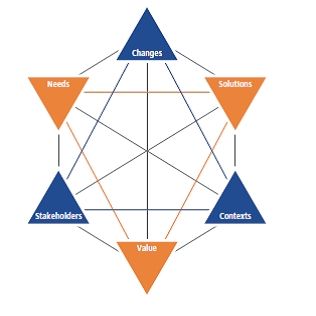
Business Analysis Core Concept Model (BACCM) – The “Big Picture” for a Strategic BA job!
In my view BABOK (Business Analysis Body of Knowledge) v3.0, by introducing the BACCM framework, has provided the world of BAs the equivalent or extension of the famous triple constraints (scope, time and cost) that once revolutionized the project management world. BACCM, in fact, encapsulates the triple constraints and goes beyond by empowering the BA in their daily task to ask fundamental yet powerful questions at every stage of business analysis work. BABOK summarizes them as:
- What are the kind of changes we are doing?
- What are the needs that we are trying to satisfy?
- What are the solutions that we are creating or changing?
- Who are the stakeholders involved?
- What do stakeholders consider of value?
- What are the contexts that we and the solution are in?
I am sure this framework will be much discussed and deliberated in the faculties of management and business analysis in the days to come. BABOK emphasizes that neither one of these six core concepts is complete without the other. A continuous and holistic evaluation of the relationship among these six concepts is suggested for robust business analysis work. For the first time, we have a BA framework that supports the consulting role of the BA professional in unlocking true value proposition of organisational change drivers. The ability to influence, negotiate, and communicate at the strategic level will be tested as BAs rise to be strategic partners.
Coming from a Blue Ocean strategy consulting background, I am tempted to view the BACCM framework as a “Blue Ocean” treasure house for the often undervalued Business Analyst. BACCM emphasis on the six core concepts and its variations (in BABOK words “No single concept holds greater importance or significance over any other concept”) empowers us to plot the “strategic canvas” of Blue Ocean Strategy, probably for the first time ever. By carefully choosing and building competencies around the six core concepts BAs can unlock the strategic potential and chart interesting career options. There is no wonder that in the recent years, BA professional competency is climbing the charts and is rated consistently in the top leadership traits. The BACCM framework is an academic endorsement of the same. It takes true leadership mettle and enormous behavioural strengths to tie together the constantly changing and interacting landscape of value generation, while being mindful of the organisational context, focused on stakeholder needs, and solution options, aligned to the change to which businesses aspire.
In my view, this is a true game changer! This elevates the BA profession perception from monolithic elicitation, analysis and management of requirements to a “trusted advisory” consulting art. It calls for competencies to evaluate the complex, continuously changing and integrated web of value drivers. It is worthwhile to note, as always, “With great power comes great responsibility”. As the industry starts embracing this strategic role of a BA in enterprise design, business architecture and business leadership, it is imperative BAs prepare (quantitatively and qualitatively) to be the business analysis pioneers of this new value exploration.
To summarise, in IIBA chief Kevin Brennan’s beautifully crafted words, “Through the BABOK® Guide v3, IIBA is advocating for the importance of business analysts as leaders who contribute to enterprise-wide success through alignment of change with strategy, and innovation in business architecture, processes, and information technology” .
marijuana for sale buy cannabis
… [Trackback]
[…] Information to that Topic: batimes.com/articles/business-analysis-core-concept-model-baccm-the-big-picture-for-a-strategic-ba-job/ […]